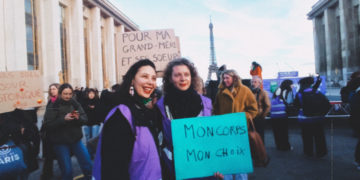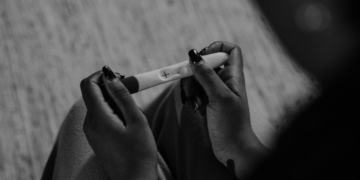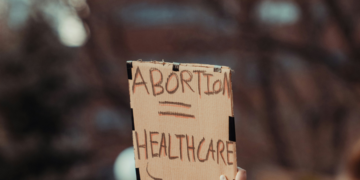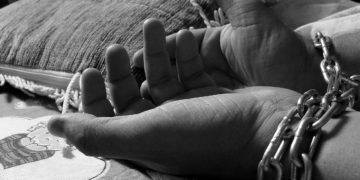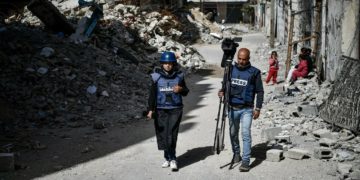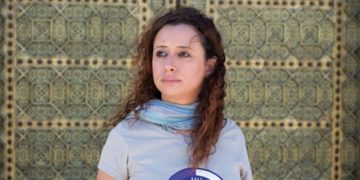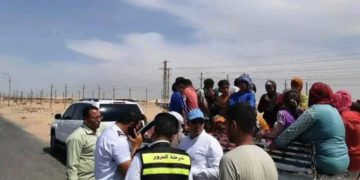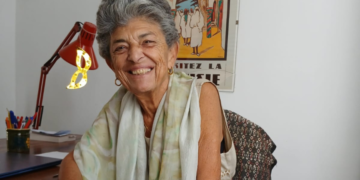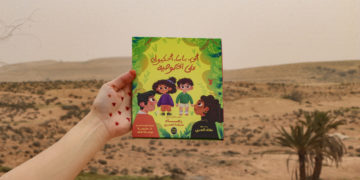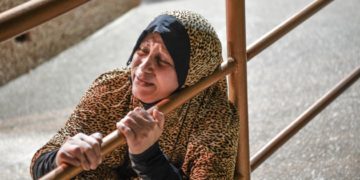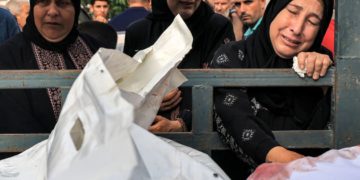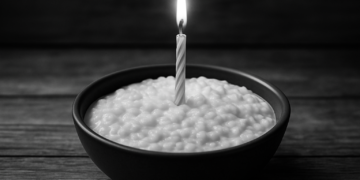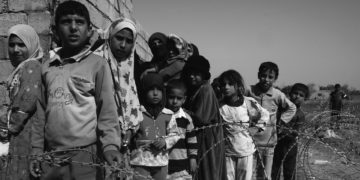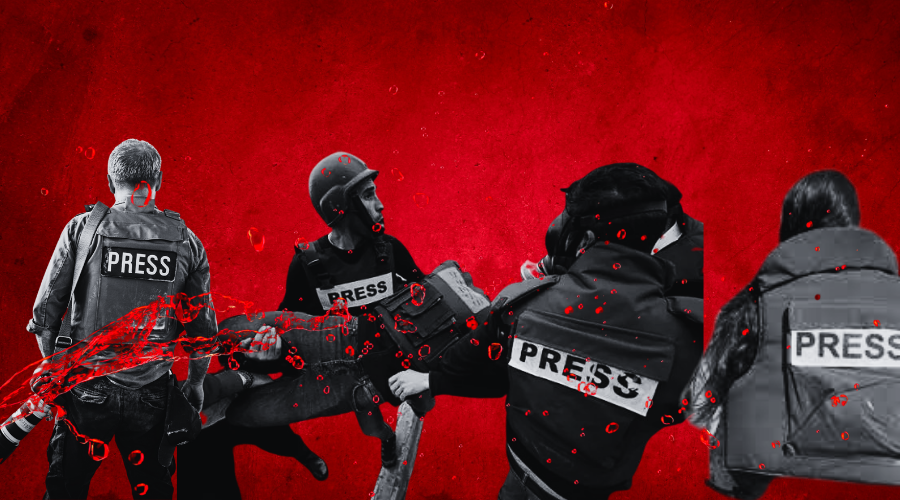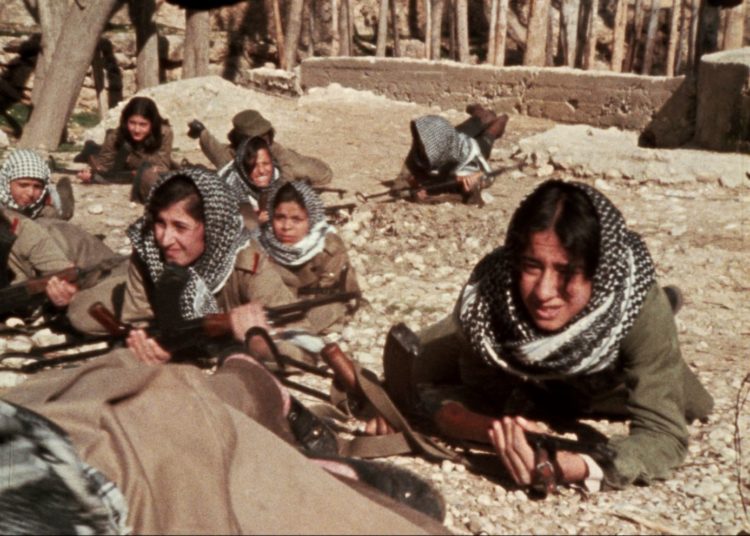This post is also available in: Français (French)
“They bomb all the time and everywhere. When a hospital or a school is bombed we go there because we have to document the casualties, interview the survivors. But we know it’s very risky because at any moment they can bomb again. And the waistcoats and helmets are useless because they don’t protect us from the bombs.
Sami Abu Salem answers questions via WhatsApp, in short voice notes, amidst the noise of the crowd in the street, taking advantage of the internet signal. It will be hours before he gets another message. “We barely have a connection. It’s hard to know if colleagues are OK and it’s very difficult to report like this,” he explains.
On 7 October Hamas killed more than 1,200 people, abducted more than 240 people and killed four journalists, including two at a kibbutz near the Strip and two at the Supernova music festival. Since then, the Israeli army has killed at least 11,000 people – more than 4,000 of them children – in the Gaza Strip. Palestinian victims now include more than 40 journalists, making Israel’s war on Gaza the conflict with the highest number of journalists killed in the shortest period of time. The illegal invasion of Iraq in 2003, one of the deadliest for journalists – 283 since 2003 – claimed the lives of eleven professionals in the first month of occupation.
Murdered in their homes
According to data compiled by the Palestinian Journalists’ Syndicate and the Committee to Protect Journalists, at least 12 journalists were killed as a result of Israeli shelling of their neighbourhoods and homes, where they were staying with family members in most cases. This was the case with Abu Hassira, a journalist with the Palestinian Authority’s Wafa news agency, who was killed on 7 November in an Israeli attack on his home that also killed 42 of his family members.
Two days earlier, it was Mohamed Al Jaja, a journalist with the press freedom organisation Press House-Palestine, who was killed along with his wife and daughters in a bombing of their home in Al-Naser, northern Gaza. Another example is freelance journalist Assad Shamlakh, whose home was bombed on 8 October, the first day of the offensive; he died along with nine members of his family.
At least three reporters were killed in their homes after spending the day documenting crimes committed by the Israeli army, according to Shorouq Assad of the Palestinian Journalists’ Syndicate in a telephone conversation. This was the case of Mohammed Abu Hatab, a video reporter for Palestine TV. He died along with 11 members of his family after their home was bombed on 2 November. They lived in Khan Yunis in southern Gaza, the region to which Israel ordered the population of the north to move to, supposedly to safety.
Rushdi Al Sarraj had also just returned to his family home after spending the day interviewing survivors of the attacks when the bombing began on the building where his family lived. He had moved there with his wife and daughter a few days earlier, thinking they had a better chance of being safe. According to later eyewitness accounts, Al Sarraj shielded his wife and one-year-old daughter with his body, who survived. He died in the ambulance transfer from shrapnel wounds. In total, as of 11 November, twelve Palestinian journalists have been killed along with their families.
“Israel knows perfectly well where everything and everyone is in Gaza. It knows by mobile phone cards, by satellite, by drone, by the information it has collected. One example: when the Palestinian telecommunications company Jawal’s facilities were bombed, five engineers went to repair them. Shortly afterwards they were killed,” explains Assad, who has more than 30 years’ experience as a reporter in the Occupied Palestinian Territories.
Investigations so far into the killings at the homes of journalists cannot clarify whether they were in response to bombings of civilian buildings, a war crime, or whether they were specifically targeted at reporters. It is standard practice for most law enforcement agencies around the world to use triangulation to identify a person’s location via their SIM card. This has been, for example, one of the most common methods used by the US to extrajudicially execute people accused of terrorism.
The German press revealed in 2013 how the German secret services had handed over information on suspected terrorists’ phones to the Pentagon and how the Pentagon had killed them by drone in Pakistan. In May of the same year, Islamic Jihad leader Ziyad al-Nakhalah claimed that the six militiamen killed during an Israeli operation had been tracked by their phones.
In recent weeks, we have also seen journalists in the Strip or their families receiving phone calls from interlocutors warning them to leave their homes if they did not want to suffer the consequences of their attacks. This was the case for Al Jazeera journalist Youmna El Sayed. Her husband received a call from someone who identified himself as a member of the Israeli army urging him to leave his home in northern Gaza because it was “in a dangerous place”. When he asked her where they could flee, given the shelling and the fact that the road leading south was full of tanks, she was told that he could not give her that information but that they had to leave immediately.
This ultimatum came five days after shelling killed the wife, two young children and the grandson of Wael Al-Dahdouh, Al Jazeera’s chief correspondent in Gaza. They were in fact in the Nuseirat refugee camp in central Gaza, where they had moved from the north, following Israeli instructions. “They take revenge on us through our children”, she declared when she found her son’s body.
According to data compiled by the Palestine Journalists Syndicate, at least three other journalists’ relatives have been killed: Mohamad Aloul has lost his four children, three sisters and three nephews; Atiyeh Darwish, his brother – in 2019 an Israeli sniper left this same journalist without an eye; and Moataz Azayzeh has had more than 15 family members taken away by shelling.
Bombings against unarmed civilians
“We have cases of journalists who were collecting testimonies from survivors and were then directly attacked. Three others who went to live in a hotel thinking they would be safer and saw bombs falling right in front of them. But let’s be clear: attacks on journalists did not start a month ago, this has been going on for 75 years,” explains Shorouq Asaad, a member of the Palestinian Journalists’ Syndicate. “I have covered hundreds of demonstrations over the decades. We Palestinian journalists always go together, with waistcoats and helmets, with press badges, and still we are shot at with live ammunition, with gas. I myself have been followed many times by snipers. We Palestinian journalists have always been targets for the Israeli army. Only now it is more brutal and dangerous. That’s why more than 60 press offices in the Strip, where journalists are usually based, have been bombed with missiles,” she stresses.
Reporters Without Borders (RSF) has filed a complaint with the International Criminal Court about war crimes committed against journalists by Israel and Hamas. The complaint details the cases of eight Palestinian journalists killed by Israeli bombing in the Strip and one Israeli journalist killed by Hamas members while covering the attack on his kibbutz, as well as the cases of two Palestinians injured and attacks on media offices in the Strip.
Israel targets Gaza journalists as terrorists
While Israeli bombardments have killed more than one journalist a day on average, several members of Netanyahu’s government have publicly repeated that they “cannot guarantee the safety” of reporters working in the Strip for international agencies such as France Press or Reuters. In doing so, they were not only urging them to stop reporting, but also differentiating them from professionals working independently or for Arab media.
While Israel boasts of breaching the principles of protection for journalists enshrined in international law, a Western media lobbying organisation called Honest Reporting – registered in New York and also based in Tel Aviv – published an undated photo of a freelance photojournalist with a Hamas leader accompanying an article accusing five journalists working for Reuters, Associated Press, The New York Times and CNN of knowing in advance of Hamas’s plans to commit the 7 October attacks.
Shortly afterwards, the Israeli prime minister’s National Directorate of Public Diplomacy called the journalists “accomplices to crimes against humanity” and called for “immediate action”. Defence Minister Benny Gantz tweeted that if the journalists knew about the massacre in advance they were “no different from terrorists and should be treated as such”. MP Danny Danon, from President Netanyahu’s Likud party, called on the same social network for the “elimination” of photojournalists “who participated in the coverage of the massacre”. And Israel’s most widely read newspaper, the far-right The Jerusalem Post, has published articles portraying Gaza journalists as Hamas propagandists.
RSF’s Middle East desk said: “The Israeli authorities have gone from claiming that they cannot guarantee the protection of journalists in Gaza to making death threats against journalists covering the conflict on the basis of suspicions that are so far not backed by arguments or evidence. Statements discrediting the integrity of an entire profession on this basis are unacceptable. They condone and incite persecution of those who risk their lives to report the news. We condemn these statements and reiterate that targeting journalists covering conflict is a war crime.
Israel’s increased criminalisation of journalism comes at a time when its parliament has passed an amendment to the anti-terrorism law that can punish anyone who “systematically and continuously consumes terrorist publications”, which are defined as “a direct call to commit an act of terrorism” or “words of praise, sympathy or encouragement for an act of terrorism”, with up to a year in prison. A confusing definition for which dozens of Palestinians in the West Bank and Israelis – including Palestinians with Israeli citizenship – are already being arrested for posts on social media or WhatsApp profiles critical of the attacks on Gaza or sympathising with the pain of its population.
For his part, Israel’s information minister has branded Al Jazeera a “propaganda” outlet for “terrorist organisations”, putting it back in the spotlight. “We have found a pattern in the bombing of Al Jazeera’s broadcasting stations in the Gaza Strip. It is clear that they consider it a target. And now, with this legal reform, what they intend to do is to accuse those who follow the news on this channel of sympathy with terrorism, to criminalise the viewers“, warns Alfonso Bauluz, journalist and president of Reporters Without Borders-Spain, in a telephone conversation.
The organisation has also demonstrated with extensive evidence that the Israeli attack that killed Lebanese Reuters reporter Issam Abdallah and injured four other journalists in southern Lebanon was deliberate. Two Israeli helicopters had previously flown over them, they and their vehicles were clearly identified with press signs, there was full visibility because of their location and because it was clear, and they had been on top of the hill for more than an hour. RSF has not been able to include this case in its complaint to the International Criminal Court because Lebanon is not a state party.
On 5 November, the Israeli army used a drone to attack the two cars in which journalist Sami Ayoub was travelling in southern Lebanon, along with his sister, his niece and her three daughters. Only Ayoub and his niece, Huda Hijazi, survived the attack. “Earlier I had told them to play near the car because the drone was overhead. I thought that this way the Israelis would know that there were children in the vehicle”, Ayoub later said in an interview. “The girls burned in front of my eyes,” he added.
“What is happening to Palestinian journalists is a war crime, part of a genocide, an attempt to cover up the truth, to hide the work they are doing. Our journalists should be protected by international law,” Assad laments from Jerusalem. “It is a shame that those who talk about freedom of the press and human rights are now silent with their complicit silence. This silence is a carte blanche for Israel to go ahead. I hope that one day we can go to the International Criminal Court and punish every single person responsible for killing journalists. I ask for protection and security so that we don’t lose any more colleagues. Assad tries to keep track of his colleagues in Gaza, but it is difficult because of the continuous cuts the internet applies to the Strip.
“The main concern for journalists in Gaza is to get food, water, a place where they can be safe. But there is none,” adds Assad, who recalls that Israel has been preventing bullet-proof waistcoats and helmets from entering the West Bank or Gaza for years. “At Egypt’s Rafah crossing, there are also dozens of protective equipment, but they don’t let them in,” he adds.
“With their arbitrary bombardment, the Israeli armed forces are eliminating journalist after journalist without restraint. All this while their unacceptable comments betray a blatant disregard for international humanitarian law,” said Jonathan Daghuer, head of Reporters Without Borders in the Middle East. His counterpart in Spain, Alfonso Bauluz, sums it up: “Gaza has become a graveyard for journalists”.
More than 1,000 journalists and some thirty Spanish, Mexican and international organisations have signed a manifesto calling on Israel to stop the bombing immediately, to protect the civilian population and journalists, to allow the international press access to the Strip, and on Hamas to release the hostages immediately.
Journalists killed by Israeli strikes in Gaza
13 November 2023
Ahmed Fatima, killed in a bombing in Gaza.
12 November 2023
Yaacoub Al-Barsh, killed in the bombing of his house in northern Gaza.
10 November 2023
Ahmed Al-Qara, killed in a bombing in the city of Khan Younis.
7 November 2023
Yahya Abu Manih, killed in a bombing in the Gaza Strip.
Mohamed Abu Hassira, killed along with 42 members of his family in a bombardment of his home in Gaza.
5 November 2023
Mohamed Al Jaja, killed along with his wife and two daughters in shelling on their home in the Al-Naser neighbourhood in northern Gaza.
2 November 2023
Mohammed Abu Hatab, killed along with 11 family members in shelling of his home in Khan Younis, southern Gaza Strip.
1 November 2023
Majd Fadl Arandas, killed by Israeli shelling in Nuseirat refugee camp.
Iyad Matar, killed with his mother in shelling in the Gaza Strip.
31 November 2023
Imad Al-Wahidi, killed along with members of his family in shelling in the Gaza Strip.
Majed Kashko, killed along with members of his family in Israeli shelling in the Gaza Strip.
30 October 2023
Nazmi Al-Nadim, killed with members of his family in shelling of his home in Zeitoun, eastern Gaza.
27 October 2023
Yasser Abu Namous, killed with his family in shelling in Khan Yunis.
26 October 2023
Duaa Sharaf, killed with her daughter in her home in the Yarmouk neighbourhood of Gaza.
25 October 2023
Saed Al-Halabi, killed in shelling of Jabalia refugee camp in the northern Gaza Strip.
Ahmed Abu Mhadi, killed in Israeli shelling.
Salma Mkhaimer, killed with her daughter in Israeli shelling in Rafah in the southern Gaza Strip.
23 October 2023
Mohammed Imad Labad, killed in Israeli shelling in the Sheikh Radwan neighbourhood of Gaza City.
22 October 2023
Roshdi Sarraj, killed in Israeli shelling in the Strip.
20 October 2023
Mohammed Ali, killed by Israeli shelling in the Gaza Strip.
19 October 2023
Khalil Abu Aathra, killed along with his brother in Israeli shelling in Rafah in the southern Gaza Strip.
18 October 2023
Sameeh Al-Nady, killed in Israeli shelling in the Gaza Strip.
17 October 2023
Mohammad Balousha, killed in Israeli shelling in the Al-Saftawi neighbourhood in northern Gaza.
Issam Bhar, killed by Israeli shelling in the northern Gaza Strip.
16 October 2023
Abdulhadi Habib, killed along with several members of his family by a missile strike on his home near the Zeitoun neighbourhood in southern Gaza City.
14 October 2023
Yousef Maher Dawas, killed along with his family by a missile fired at their home in Beit Lahia in the northern Gaza Strip.
13 October 2023
Husam Mubarak, killed by Israeli shelling in the northern Gaza Strip.
12 October 2023
Ahmed Shehab, killed along with his wife and three children by Israeli shelling of their home in Jabalia in the northern Gaza Strip.
11 October 2023
Mohamed Fayez Abu Matar, killed by Israeli shelling in Rafah in the southern Gaza Strip.
10 October 2023
Salam Mema, killed by shelling of Jabalia refugee camp in the northern Gaza Strip.
Saeed al-Taweel, killed when Israeli warplanes attacked an area in the Rimal district of Gaza City, where many media outlets are based.
Mohammed Sobh, killed when Israeli warplanes attacked an area in the Rimal district of Gaza City, where many media outlets are based.
Hisham Alnwajha, injured by Israeli bombing in the Rimal district. He died days later.
8 October 2023
Assaad Shamlakh, killed along with nine members of his family in Israeli shelling of his home in Sheikh Ijlin in the southern Gaza Strip.
Mohammad Al-Salhi, killed near a refugee camp in the Gaza Strip.
Mohammad Jarghoun, killed in east Rafah in the southern Gaza Strip.
Ibrahim Mohammad Lafi, killed at the Erez crossing in the Gaza Strip.
